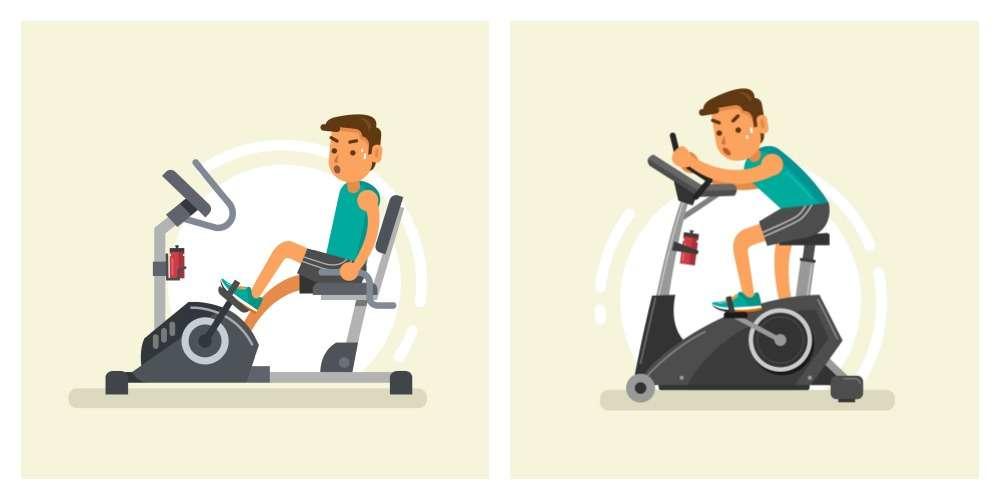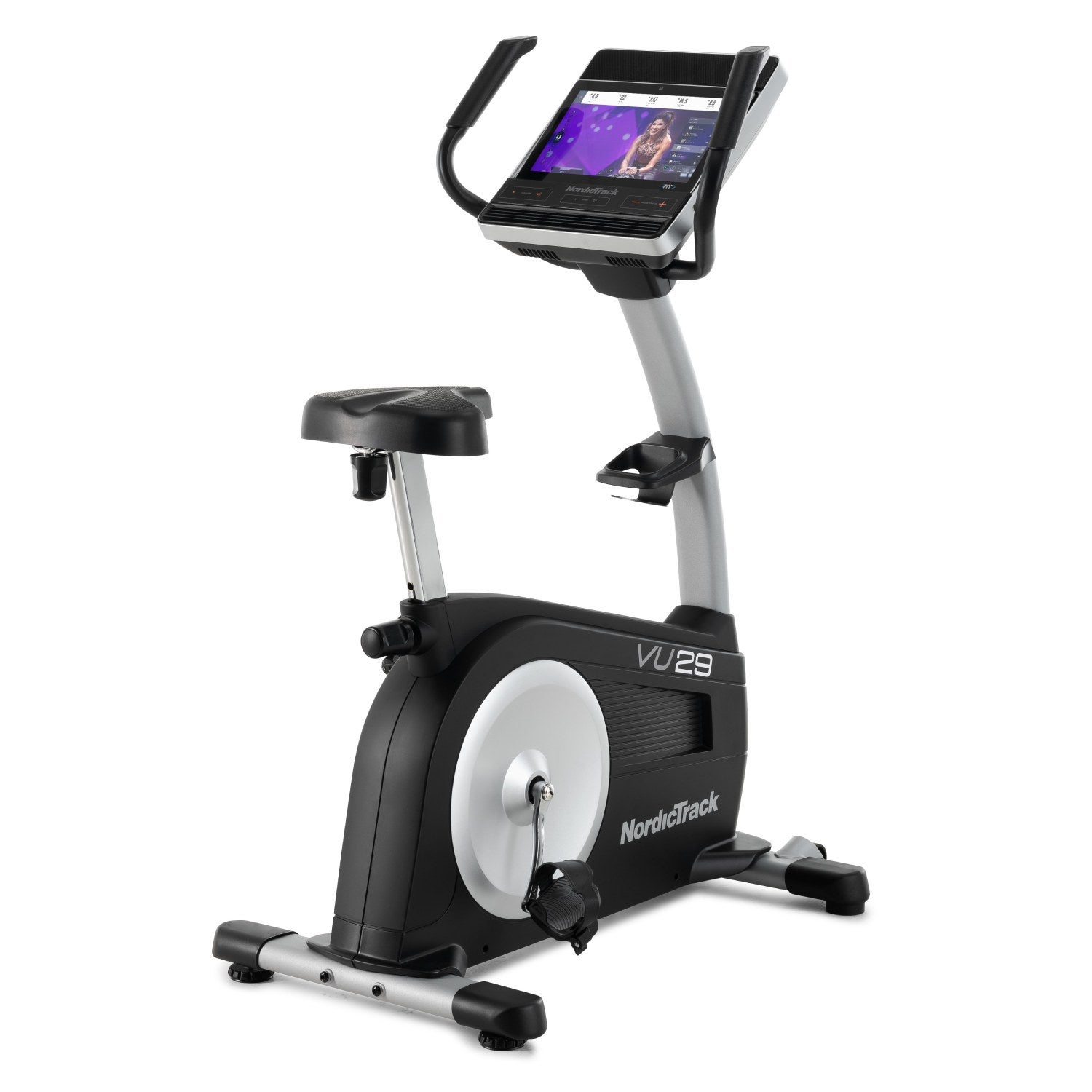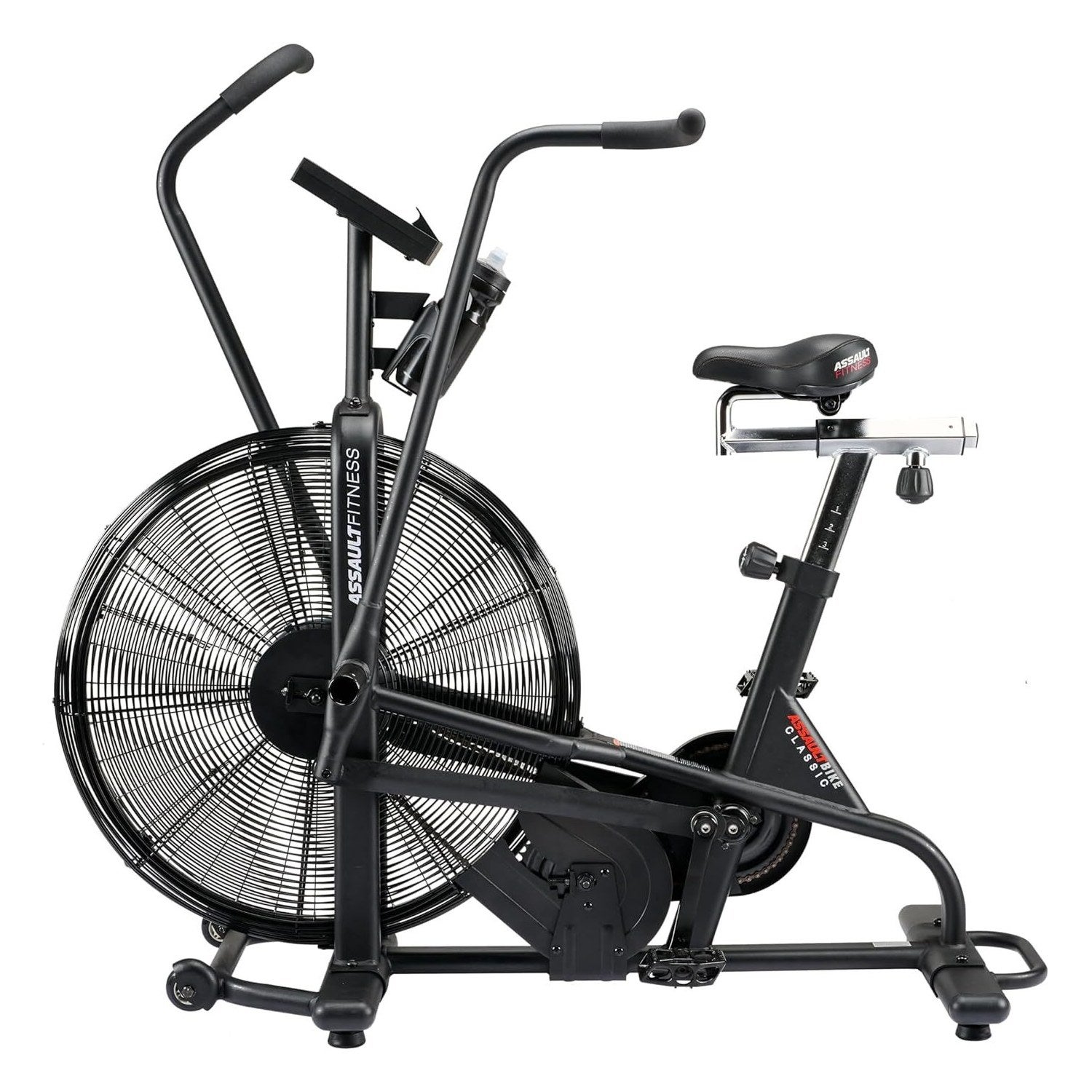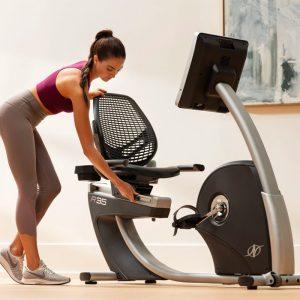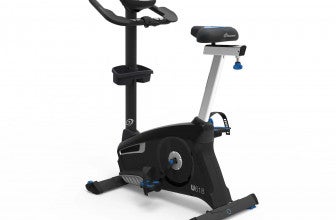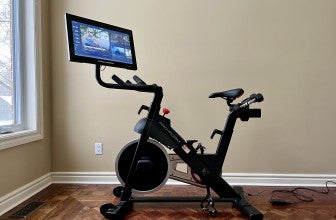If you’re about to purchase your very first piece of home gym equipment, there’s no doubt you’re pretty excited. You may have some new goals in place and are antsy to get started on your new program. But first, the decision: recumbent vs. upright bike? Which one is right for you? Will one get you in shape faster than the other? Which will be easiest on your joints?
These are just a few of the important questions that you will want to consider as you go about making this decision. Let’s give you some comparison details to help ensure you end up making the right purchase.
Once you’ve read this article, you can check out our The 9 Best Exercise Bikes of 2024 where our fitness editor, Brian Boyce (CPT) has reviewed the best bikes per category and has made his expert recommendations on which bike to look to get.
| Recumbent Bike | Upright Bike | |
| Calorie Burn | Moderate (400+ calories/hr.) | Moderate to High (500+ calories/hr.) |
| Injury Risk | Low | Moderate |
| Muscles Worked | Quads, Hamstrings, Glutes, Calves | Quads, Hamstrings, Glutes, Calves, Erector Spinea, Core, Shoulders, Triceps, Forearms |
| Ease Of Use | Good | Moderate |
| Ability To Progress | Moderate | Moderate |
| Transferability | Low | High |
| Who It’s Best Suited For | Older Trainees, Those Recovering from Injury, Those Working to Build Endurance | Athletes, Young Adult Trainees, Those Hoping to Boost Speed and Power |
| Target Fitness Benefits | Improved Strength Output, Enhanced Cardiovascular Endurance, Fat Burning Benefits | Improved Strength Output, Enhanced Cardiovascular Endurance, Fat Burning Benefits, Improved Speed and Power |
Now that you’ve seen this brief overview, let’s elaborate on each factor so you know which option will help you meet your fitness goals.
Calorie Burn
The calorie burn is one of the top factors that most people consider. The faster you burn calories, the faster you’ll be losing weight. How does the stationary bike vs. recumbent bike stack up?
When it comes to calorie burn, both bikes tend to burn around the same amount. You aren’t going to see much difference in either bike as long as you are putting in the same amount of effort. Both bikes will burn around 500 calories per hour, assuming you are a 145 lb. individual who is going at a moderate pace. If you turn up the dial and go at a vigorous pace, you can expect to burn up to 600-700+ calories per hour.
Calories burned on recumbent bike are slightly less since your upper body is completely supported by the machine. The difference is not that significant, however, so don’t let this be your determining factor. In the grand scheme of things, the difference in caloric burn per hour is unlikely to make that much of a difference. Choosing the bike you enjoy and are more likely to stay consistent with is far more important.
To determine your best fit, ask yourself, which bike do you feel most comfortable on? Which bike allows you to put forth the most effort? Once you answer these questions, that’s the bike that will typically burn more calories over the long term.
The more comfortable you are, the harder you work. As a result, the more energy you’ll burn off. This is also important as you get into high intensity interval training (HIIT), because the harder you can push during this style of training, the greater the EPOC (excess post exercise oxygen consumption) you elicit, allowing for higher calorie burn hours after your workout is finished.
As you can see, there are definitely some differences to factor in when deciding recumbent bike vs upright bike. This said, both bikes are excellent for boosting your overall fitness level, so you should see great results regardless of which one you go with.
Injury Risk

The two bikes differ because, with the upright bike, all of your body weight is coming down on the two tailbones. With the recumbent bike, as you’re leaning against the back rest, some of your weight is being transferred. It’s also easier to adjust your center of balance on this bike slightly back, which means more weight is coming down on the fleshy parts of the buttocks rather than right on that center tailbone.
While this isn’t really an ‘injury’ per say, it can make continuing on with your sessions very challenging.
In terms of true injuries, the upright bike does come out as a higher risk option because there will be more stress being placed on the quad muscles with this movement pattern, thus the potential for aggravation of the knee cap is higher. Additionally, with no back support at all, the risk for lower back pain will be marginally higher with the upright bike.
Muscles Worked
When you’re exercising on the stationary bike vs. recumbent bike, you’re going to work slightly different muscles. The primary muscles worked on both machines are very similar. Both use all the lower body muscles quite well as biking proves to be a great leg-strengthening activity.
Because you don’t have any back support on the upright bike, this calls into play the spinal column and core to keep the body upright. You can also expect your lower back and shoulders to be worked to some degree as they help to keep you stabilized.
Since the upright bike requires you to lean over the handle bars more, this increases the use of the upper body to grip those bars, thus some of the upper body muscles will engage for stabilization. Will they really get a tough workout? No. Do not consider the stationary upright bike a good upper body workout. But the small degree of additional muscle activation is worth mentioning.
The quads and calves will be worked with both bike choices; however, the hamstrings will not come into play as much on the stationary bike as they will on the recumbent bike. The upright bike works the hamstrings more as a secondary rather than primary mover.
Ease Of Use
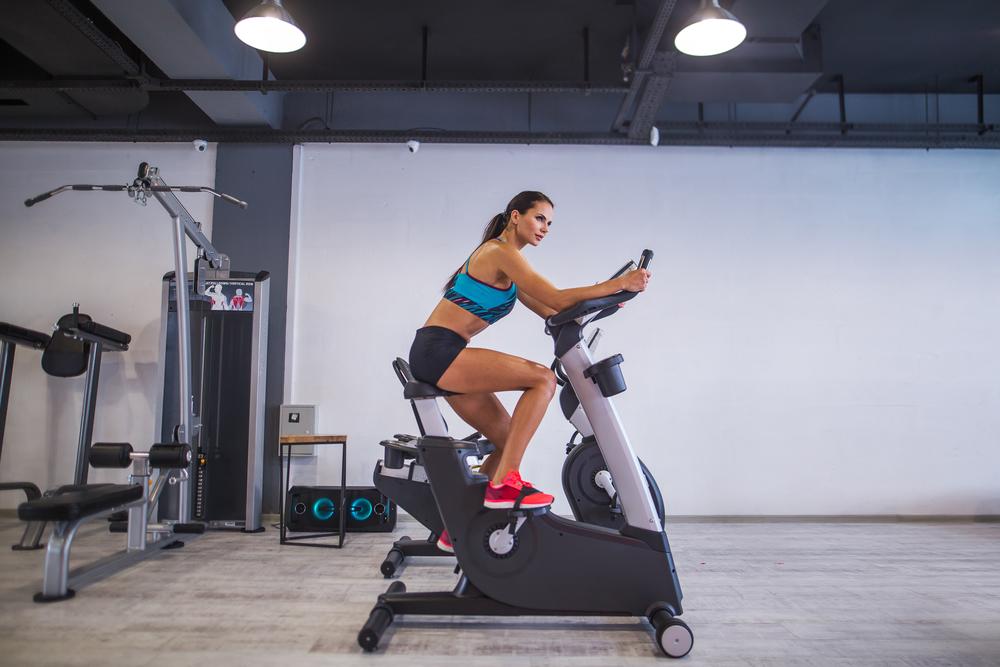
The upright bike is meant to mimic the action of regular biking, so most of us will be able to just get on and begin pedaling away.
This isn’t to say the recumbent bike is hard and has a steep learning curve – it’s actually relatively easy. But it will be a new movement pattern for most of you and take some getting used to. Typically after a few days on the recumbent bike, things will feel completely natural, and you’ll be a pro at this type of cycling.
Ability To Progress
How do recumbent vs. upright bikes accommodate your ability to progress? In this category, the two options are a close tie as you can increase the intensity by cranking up the resistance, forcing your muscles to work harder with each rep that you make. You can also focus on increasing your speed if you want to build that quickness and power with your fitness level.
Beyond those two methods, there’s no real way of progressing with the bike, so you’re limited to these. As long as you focus on increasing one or the other over time, you should see good results from your program.
Who It’s Best Suited For
When thinking of who these bikes are best suited for, first note that anyone can successfully use them without a problem. There really are no limitations on someone not using either of these bikes, provided they aren’t suffering from a knee injury, in which case biking should be avoided. This said, each bike will specialize in helping a certain type of individual a bit more than others, so that’s what we’re referring to here.
Because the stationary bike is more physically demanding with no backrest to offer support, it’s usually better suited for younger adults than older adults. This said, if you are an older adult who is strong and fit, then this may not be a concern. But if stability and potential back pain is a concern, that’s more reason to use those backrests recumbent bikes provide.
The stationary bike is also a good option for those who are hoping to improve their athletic performance. If you’re cycling as a sport, you’ll get better transfer over benefits from using this bike over the recumbent bike as the pattern is nearly identical. Additionally, it’s easier to generate power when on the stationary bike, a concept we’ll discuss in a moment, so this tends to serve athletes better as well.
Speaking of power, the reason why the stationary bike wins out is because, when you are in the upright position and can lean over the bike’s handlebars, it’s generally easier to pedal as fast as possible while keeping the body in a fixed position. If you’ve ever tried to pedal at 100% effort for speed on the recumbent bike, you may have noticed you start to feel a bit uncomfortable. This bike isn’t build as well for power development, so if that’s your goal, choose the stationary bike. Is the stationary bike checking all the boxes of your fitness needs and preferences? Check out some of our top picks for best stationary bikes here!
What the recumbent bike is good for is endurance. Most people will find they can bike for longer on the recumbent bike due to the fact that both the hamstrings and the quad muscles are working intensely together versus just the quad muscles working almost alone. When most of the emphasis is being placed on the quad muscles, they are more likely to burn out quickly and stop being able to exercise at the intensity needed to carry out the movement for a prolonged period of time. Due to ease in use and seat safety, recumbent bikes are often recommended for wheelchair users, people with mobility limitations, seniors, and those suffering lower limb and/or back injuries. If this sounds like the solution for you, check out our roundup of the best recumbent bikes on the market.
Target Fitness Benefits
So what are the fitness benefits you’ll experience with each bike? Both are great for increasing cardiovascular endurance. As noted though, the recumbent bike may come out slightly over the stationary bike when considering this factor.
The stationary bike will be more effective in developing top speed and the ability to work hard against force. This is why athletes are so well served by it. Both bikes will help you burn fat since they each torch an appreciable amount of calories, which is key for creating the fat loss deficit needed for weight loss.
So there you have the pros and cons of the recumbent vs. upright bike. Both are great options for someone who loves to cycle and is looking to get in a fantastic lower body workout. With continual effort, you should have no problem seeing results in both your cardiovascular fitness level as well as your total strength output.
Best Recumbent Bike
Our fitness expert, Brian Boyce (CPT), recommends the NordicTrack VU29 for those looking for the best Recumbent bike. You can read his review on it here: NordicTrack Commercial VU29 Review
Best Upright Bike
Our fitness expert, Brian Boyce (CPT), recommends the Assault Fitness AirBike Review for those looking for the best Upright bike. You can read his review on it here: Assault Airbike Review
